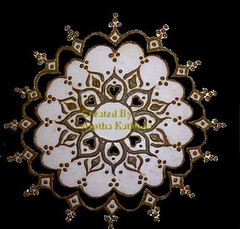Swastikas .... the loaded symbol

In one of my earlier posts I had mentioned about swastikas being a common design pattern in Indian mehandi. So, today when my friend Jen asked me if I knew what a loaded word "Swastikas" was here, I realized I had to write a post to explain the significance of swastikas in the Indian culture.

The Swastika is a holy symbol in the Hindu and Jain religions. Seen at most Indian temples as well as entrances of houses (yes its true, you'll find swastikas made of vermillion paste on the door frames), at weddings, festivals and celebrations, the swastika is used in religious and civil ceremonies in India. The word swastika is derived from the Sanskrit word svastika meaning any lucky or auspicious object, and in particular a mark made on things to denote good luck.
I am aware that in the west, swastika has been associated with Nazism, which I believe led to Jen's question. This has led to confusions to the use of the symbol in the pre-Nazi era as well its religious and sacred significance in other cultures. I hope that this post will help you understand the alternative meanings associated with the symbol in other cultures. There has and will always be more good than bad associated with this word in most cultures :).
For more information on this, check out Swastikas on Wikipedia
** Note that the information and photographs used above were obtained from Wikipedia and variety of sources.
Labels: body art, henna, mehandi, mehendi, patterns, styles, swastikas, tattoos, temporary tattoos, types
 The Art of Henna designing
The Art of Henna designing

